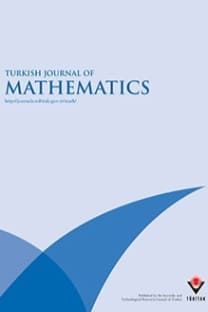Star-likeness associated with the exponential function
Star-likeness associated with the exponential function
___
- [1] Ahuja OP, Kumar S, Ravichandran V. Application of first order differential subordination for functions with positive real part. Studia Universitatis Babeș-Bolyai Mathematica 2018; 63 (3): 303-311.
- [2] Ali RM, Cho NE, Ravichandran V, Kumar SS. Differential subordination for functions associated with the lemniscate of Bernoulli, Taiwanese Journal of Mathematics 2012; 16 (3): 1017-1026. doi: 10.11650/twjm/1500406676
- [3] Ali RM, Ravichandran V, Seenivasagan N. Sufficient conditions for Janowski star-likeness. International Journal of Mathematics and Mathematical Sciences 2007; Article ID 62925, 7. doi: 10.1155/2007/62925
- [4] Gandhi S, Kumar S, Ravichandran V. First order differential subordinations for carathéodory functions. Kyungpook Mathematical Journal 2018; 58 (2).
- [5] Goodman AW. Univalent Functions Volume I. Tampa, FL, USA: Mariner Publishing Company, Incorporated, 1983.
- [6] Janowski W. Extremal problems for a family of functions with positive real part and for some related families. Annales Polonici Mathematici 1970/1971; 23: 159-177. doi: 10.4064/ap-23-2-159-177
- [7] Kumar S, Ravichandran V. Subordinations for functions with positive real part. Complex Analysis and Operator Theory 2018; 12 (5): 1179-1191. doi: 10.1007/s11785-017-0690-4
- [8] Ma WC, Minda D. A unified treatment of some special classes of univalent functions. In: Proceedings of the Conference on Complex Analysis (Tianjin, 1992) - Conference Proceedings Lecture Notes Anal., I. Cambridge, MA: International Press, 1994. pp. 157-169.
- [9] Mendiratta R, Nagpal S, Ravichandran V. On a subclass of strongly star-like functions associated with exponential function. Bulletin of the Malaysian Mathematical Sciences Society 2015; 38 (1): 365-386.
- [10] Miller SS, Mocanu PT. Differential subordinations and univalent functions. The Michigan Mathematical Journal 1981; 28 (2): 157-172.
- [11] Miller SS, Mocanu PT. Differential Subordinations Volume 225 of Monographs and Textbooks. In: Pure and Applied Mathematics, New York, NY, USA: Marcel Dekker, Incorporated, 2000.
- [12] Nunokawa M, Obradović M, Owa S. One criterion for univalency. Proceedings of the American Mathematical Society 1989; 106 (4): 1035-1037. doi: 10.2307/2047290
- [13] Omar R, Halim SA. Differential subordination properties of Sokół-Stankiewicz star-like functions. Kyungpook Mathematical Journal 2013; 53 (3): 459-465. doi: 10.5666/KMJ.2013.53.3.459
- [14] Raina RK, Sokół J. On coefficient estimates for a certain class of star-like functions. Hacettepe Journal of Mathematics and Statistics 2015; 44 (6): 1427-1433.
- [15] Rønning F. Uniformly convex functions and a corresponding class of star-like functions. Proceedings of the American Mathematical Society 1993; 118 (1): 189-196.
- [16] Sharma K, Ravichandran V. Applications of subordination theory to star-like functions. Bulletin of Iranian Mathematical Society 2016; 42 (3): 761-777.
- [17] Sokół J. On sufficient condition to be in a certain subclass of star-like functions defined by subordination. Applied Mathematics and Computation 2007; 190 (1): 237-241. doi: 10.1016/j.amc.2007.01.034
- [18] Sokół J, Stankiewicz J. Radius of convexity of some subclasses of strongly star-like functions, Zeszyty Nauk. Politech. Rzeszowskiej Mat 1996; 19: 101-105.
- [19] Tuneski N. On the quotient of the representations of convexity and star-likeness. Mathematische Nachrichten 2003; 248/249: 200-203. doi: 10.1002/mana.200310015
- ISSN: 1300-0098
- Yayın Aralığı: 6
- Yayıncı: TÜBİTAK
Noureddine FERFAR, Said MAZOUZI
Salah Eddine RIHANE, Bernadette FAYE, Florian LUCA, Alain TOGBE
Abdurrahman Muhammed ULUDAĞ, Hakan AYRAL
Luis Pinheiro De CASTRO, Rita Correia GUERRA, Nguyen Minh TUAN
The spectral expansion for the Hahn–Dirac system on the whole line
Bilender PAŞAOĞLU ALLAHVERDIEV, Hüseyin TUNA
An inequality on diagonal F -thresholds over standard-graded complete intersection rings
